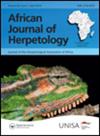撒哈拉沙漠蓝眼龟Mauremys leprosa saharica(Testudines:Geoemydidae)对盐度和脱水的耐受性
IF 0.9
4区 生物学
Q3 ZOOLOGY
引用次数: 7
摘要
摘要撒哈拉蓝眼池龟的边缘种群Mauremys leprosa saharica位于非洲西北部撒哈拉以南地区的物种分布范围内,面临着干旱气候、人为和气候变化介导的水和土地盐碱化的极端环境条件。在目前的研究中,我们调查了摩洛哥南部德拉河下游Sidi El Mehdaoui绿洲的一个小而孤立的M.l.saharica种群,以评估其渗透压和离子调节能力以及对盐度和脱水的耐受性。捕获后,对海龟进行称重和测量外壳尺寸,并采集血液和排泄尿液。进行了暴露于不同盐度水平(0%、35%和50%海水)和出水维护(估算模拟)的试验。在测试前后,测定血浆和排泄尿液中的渗透压和Na+、Cl-、K+和尿素浓度,并测量血液中的血糖。海龟能够在盐度高达24%(8.4ppt)的微咸水中生存。他们排出的尿液对血浆具有低渗性,这表明他们可以利用膀胱水储备进行渗透压和离子调节,直到达到等渗透压水平,超过该水平就会发生渗透压和电离性不平衡。实验测试表明,这些海龟的渗透压和离子调节能力相对有限,不足以使它们在微咸水/盐水或无水中长期生存,因为脱水表明体重逐渐减轻到临界阈值。与人类活动和气候变化有关的干旱、盐碱化和栖息地破碎化加剧,构成了巨大的威胁,可能会造成超过物种阈值的栖息地,使脆弱的撒哈拉池塘龟小边缘种群长期存在。因此,迫切需要对这些种群及其栖息地采取保护措施。本文章由计算机程序翻译,如有差异,请以英文原文为准。
Tolerance to salinity and dehydration in the Sahara Desert blue-eyed turtle, Mauremys leprosa saharica (Testudines: Geoemydidae) from a brackish pond in the Lower Draa basin, southern Morocco
ABSTRACT The marginal populations of the Sahara blue-eyed pond turtle, Mauremys leprosa saharica, in the southern-most species distribution range in the pre-Saharan areas of north-west Africa, are faced with extreme environmental conditions of arid climate and anthropogenic and climate change mediated water and land salinisation. In the current study, we investigated a small and isolated population of M. l. saharica at Sidi El Mehdaoui oasis in the Lower Draa River, southern Morocco, in order to assess its osmo- and iono-regulatory abilities and tolerance to salinity and dehydration. Upon capture, turtles were weighed and measured for shell dimensions and blood and voided urine were taken. Tests of exposure to different levels of water salinity (0%, 35%, and 50% seawater) and maintenance out of water (estivation simulation) were carried out. Osmolalities and Na+, Cl−, K+, and urea concentrations were determined in plasma and voided urine, and glycaemia was measured in blood, before and after tests. Turtles were able to survive in brackish waters with a salinity as high as 24% seawater (8.4 ppt). Their voided urine was hypotonic to plasma, which indicated that they could use their bladder water reserves for osmo- and iono-regulation until the iso-osmocity level beyond which osmotic and ionic anhomeostasy can occur. Experimental tests showed that the osmo- and iono-regulatory capacities of these turtles are relatively limited, and not enough effective to allow them to survive for long-term periods in brackish/saline waters or out of water, because of dehydration indicated by progressive weight loss to a critical threshold. The increased drought, water salinisation and habitat fragmentation related to anthropogenic activities and climate change, represent great threats that can create habitats exceeding the species’ threshold for a long-term persistence of the vulnerable small marginal populations of the Saharan pond turtle. So, conservation measures of these populations and their habitats are urgently needed.
求助全文
通过发布文献求助,成功后即可免费获取论文全文。
去求助
来源期刊

African Journal of Herpetology
ZOOLOGY-
CiteScore
3.00
自引率
6.70%
发文量
15
审稿时长
>12 weeks
期刊介绍:
African Journal of Herpetology (AJH) serves as an outlet for original research on the biology of African amphibians and reptiles. AJH is an interdisciplinary journal that publishes original articles and reviews from diverse fields and disciplines, such as conservation, phylogenetics, evolution, systematics, performance, physiology, ecology, behavioural ecology, ethology, and morphology.
The Journal publishes two issues a year. There are no page charges .
 求助内容:
求助内容: 应助结果提醒方式:
应助结果提醒方式:


